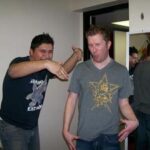The key thing to remember when writing standup material is that there is no formula, no rules, and no shortcuts. While the majority of comedians use similar structures, comedians as diverse as Mitch Hedberg and Richard Pryor have used unorthodox styles with impressive results. So, the most important thing to remember in comedy is to do what you think is funny. If it works, great; if it doesn’t, play with it, tinker with it, change it or even junk it. But you have to be yourself, in your act and your material.
There are certain guidelines, tips and tricks to help you write new material and improving existing material. This format is far too short to cover those in detail (please see the list of recommended books for this topic – I highly recommend Judy Carter’s The Comedy Bible and her associated website), but we can cover the basics of joke writing, and some of the common mistakes new writers make with their material.
Where Does Funny Come From?
Honestly, who knows? Johnny Carson was most famous for his reaction to jokes that fell flat — jokes written by a tremendously talented stable of writers who were sure that his monologue jokes were funny. And they were wrong. Sociologists comedians, writers, and everyone else have analyzed humor ad nauseum — and made little progress.
In standup terms, one important thing to remember is that “funny” comes from “serious”. Lenny Bruce attacked racism and the Catholic Church (among many, many other targets); George Carlin tackled television censors and war; and one of Richard Pryor’s most famous bits discussed the time he nearly burned to death. Even jokes about marriage, travel, money and other common subjects discuss serious, often mundane subjects. A funny story about your crazy friend after twelve shots of whiskey isn’t a joke (and probably won’t even be funny on stage). Write material based on life, society, and the troubles we all face.
The Setup and The Punchline
Despite the common complaint that standup comedy has become defined more by “attitude” and less by writing style, most jokes still follow the standard structure of setup followed by punchline. The setup “sets up” the joke by giving the audience the information and direction of the joke. The punchline provides the humor. To use an old joke, the setup would be, “My Aunt Lucy is so old.” The punchline would be, “Her Social Security number is 7.” Most beginning comedians make the mistake of taking too long with their setups. No matter how good a punchline is, a set cannot flow if your setups are taking thirty, forty-five, or even twenty seconds. One of the best tips I was ever given was, “Take your best fifteen minutes and trim it to ten.” Even if you can’t cut that much, the few minutes you can cut out will give you a tighter, funnier set. Limit the setup to the information required for the joke. If the joke is about your Aunt Lucy, you don’t need to tell us that she’s your favorite, or she’s cute, or she’s not really your aunt but your mother’s aunt. The audience probably doesn’t care enough (and neither do you, apparently, making jokes about your poor sweet old Aunt Lucy).
As for the punchline, it’s important to remember that it needs to be funny. It sounds basic, but I’ve seen so many beginning comedians set up a perfectly funny situation, only to follow up with, “Can you believe that?” or “I didn’t know what to do.” Well, you should know. You’re now a comic. It’s your job not only to find humor, but to bring it out. A good friend of mine who is not only a comic but who booked comedians in New York City bars once commented about a group of auditioners, “They all think they’re doing observational humor, but it’s just observations. There’s no punchlines there.”
Tags
A ‘tag’ refers to any addition made to a joke after a punchline. Usually a quick one-liner, or a second or third punchline, the tag keeps the momentum of the joke going and builds on the humor of the original punchline. Tags are a relatively advanced topic — even established comics take weeks, even months, to build a new joke out to its fullest possible extent — they are worth considering as you review your material. Can you add another punchline? Can you add a self-deprecating remark, or a brief comment on your own joke? Three punchlines are better than one — and three laughs are definitely better than one.
Tags are also important to consider, as they emphasize the point that the best source of new material is existing material. Recently I sat down and watched a tape I made sometime ago – back when I had only about ten minutes of decent material (decent being a relative term). I discussed six topics in ten minutes. Now, in thirty minutes, I discuss seven topics – including all six topics from way back when. One joke about cigarettes has become four; one joke about weddings became three bits that take almost five minutes. The point is, as you grow as a comedian, your existing jokes should grow with you. Once you’ve hit a topic once, it is easier for the audience to come along on the next joke and easier for you as a writer to find more nuggets of humor.
If you do one joke about a prescription drug commercial (a common topic these days), try for two more. If that commercial was funny — are there others you can attack as well? What does the language of the commercial say about our society? Is there a common thread through a number of commercials that you can comment on?
The Unique and the Common
Stand-up comedy, when successful, is essentially about finding an unique viewpoint on common experiences. There is a reason why comics constantly pore over subjects such as relationships, television, and politics – because they are shared experiences among all of us, which are easily understood and relatable. It is important that your jokes cover topics that your audience can understand. If you’re doing a joke about your poor old Aunt Lucy, the joke can’t just be funny around the dinner table at Thanksgiving. What is it about Aunt Lucy that all, or even most, of the audience can relate to their own aunt or grandmother? Too many beginning comics seem to do jokes that fit the old cliche response, “I guess you had to be there.”
On the flip side, it is important to remember that your joke be unique. Sure, Michael Jackson is weird – but why is your joke worth telling? What is your take on it? What do you bring to the table? It is important to watch other comedians as you begin. Are they doing similar jokes to yours? If so, you might want to consider dropping those jokes. It is painful to cut two minutes when you only have six, but in the long run it will push you toward becoming a unique, successful comedian.
“Hack”
“Hack” is a very powerful word in stand-up comedy. “Hack” jokes are jokes about topics that have been covered ad nauseum. One example is, “If the black box doesn’t break, why don’t they make the whole plane out of the black box?” (For a complete list of hack jokes and hack topics, you can see a great list at http://www.chucklemonkey.com/hacklist.htm ). “Hack” jokes are a perfect example of the need for a comic to be unique.
Being a “hack”, on the other hand, refers to a comedian who steals joke from other comedians. I cannot stress strongly enough that this is not acceptable under any circumstances. I have read and heard elsewhere that beginning comics may “re-write” other comedians jokes to learn their voice or style. This is completely untrue. There is no such thing as “borrowing” a joke, and even taking a part of a joke is flat-out wrong. Should you get a reputation as a hack, your fellow comedians will disown you, and rightfully so. Even worse, you will never be able to look yourself in the mirror, or proudly refer to yourself as a stand-up comic.
It is true that two comedians can come up with similar jokes independently. Comics refer to this as “parallel thinking.” Your reaction to this depends on the situation. If another open-miker in a different town has the same joke, perhaps you can keep yours. But should you see Chris Rock or Lewis Black doing a similar joke, you need to junk yours. True, it’s painful, but it’s not worth a solitary joke to be even suspected by an audience member or a fellow comedian as a hack.
Trial and Error
For all the books, and seminars, and articles like this one, writing comedy material is a personal process. You need to find your voice and your style. The most important thing to remember is that it takes time. Ask any headliner, feature, or MC, and ask them how good their act was six months, or two years in. I watch tapes from six months ago and shudder at some of the jokes, which now seem weak.
If you write a joke, and you think it’s funny, try it on stage. If it doesn’t work, try it again. Play with the delivery, tinker with the setup. Change “eleven” to “thirteen”; pause in a different place. The difference that a seemingly trivial change in delivery, timing, or material can make is astounding.
Stand-up is unfortunately a trial-and-error proposition. You will write jokes that you think are the funniest thing you’ve ever written, and they just won’t pan out. And you will write jokes that you don’t even think are funny, and they will kill. But you need to try them all, on stage. Not to your friends, or mom, or significant other, but on stage. If they don’t work, suck it up and move on. But when they do work – you’ll quickly understand why being a stand-up comic is so exciting, and rewarding.
This article was originally published on Suite101.com, although subsequent changes have been added.





